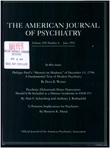Physiological evidence of exaggerated startle response in a subgroup of Vietnam veterans with combat-related PTSD
Abstract
One of the diagnostic criteria for posttraumatic stress disorder (PTSD) is an exaggerated startle response; however, this phenomenon has not been verified empirically. The authors compared 20 Vietnam combat veterans with PTSD and 18 combat veterans without PTSD on the eyeblink reflex electromyographic response of the startle reaction. Subjects in both groups who failed to show an eyeblink response to the startle stimuli were eliminated from further analyses. Among the remaining subjects, the 13 with PTSD had a significantly greater startle response amplitude than the 12 control subjects at intermediate intensities of acoustic stimuli. The relationship between startle responsivity and both negative and positive symptoms was also investigated.
Access content
To read the fulltext, please use one of the options below to sign in or purchase access.- Personal login
- Institutional Login
- Sign in via OpenAthens
- Register for access
-
Please login/register if you wish to pair your device and check access availability.
Not a subscriber?
PsychiatryOnline subscription options offer access to the DSM-5 library, books, journals, CME, and patient resources. This all-in-one virtual library provides psychiatrists and mental health professionals with key resources for diagnosis, treatment, research, and professional development.
Need more help? PsychiatryOnline Customer Service may be reached by emailing [email protected] or by calling 800-368-5777 (in the U.S.) or 703-907-7322 (outside the U.S.).



